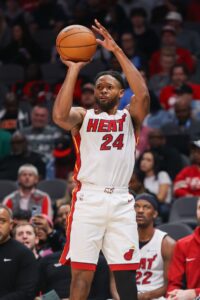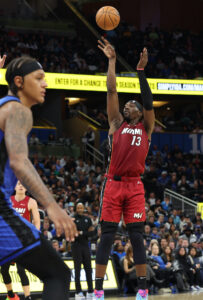Hoops Rumors is checking in on the 2024 offseason for all 30 NBA teams, recapping the summer’s free agent signings, trades, draft picks, departures, and more. We’ll take a look at each team’s offseason moves and consider what might still be coming before the regular season begins. Today, we’re focusing on the Miami Heat.
Free agent signings
 Haywood Highsmith: Two years, $10,816,000. Re-signed using Bird rights.
Haywood Highsmith: Two years, $10,816,000. Re-signed using Bird rights.- Kevin Love: Two years, $8,000,000. Re-signed using Early Bird rights.
- Thomas Bryant: One year, minimum salary. Re-signed using minimum salary exception. Waived right to veto trade.
- Alec Burks: One year, minimum salary. Signed using minimum salary exception.
- Zyon Pullin: One year, minimum salary. Non-guaranteed (Exhibit 10). Signed using minimum salary exception.
- Isaiah Stevens: One year, minimum salary. Non-guaranteed (Exhibit 10). Signed using minimum salary exception.
Trades
- Acquired the draft rights to Pelle Larsson (No. 44 pick; from Rockets) and cash (from Hawks) in a three-team trade in exchange for the draft rights to Nikola Djurisic (No. 43 pick; to Hawks).
Draft picks
- 1-15: Kel’el Ware
- Signed to rookie scale contract (four years, $20,466,072).
- 2-44: Pelle Larsson
- Signed to three-year, minimum-salary contract ($5,408,801). First year guaranteed. Second year partially guaranteed. Third-year team option.
Two-way signings
Departed/unsigned free agents
Other moves
- Signed Bam Adebayo to a three-year, maximum-salary veteran extension that begins in 2026/27. Projected value of $165,348,864. Includes third-year player option.
- Waived Orlando Robinson.
Salary cap situation
- Operating over the cap ($140.6MM), over the luxury tax line ($170.8MM), and between the first tax apron ($178.1MM) and second tax apron ($188.9MM).
- Carrying approximately $184.8MM in salary.
- No hard cap.
- Taxpayer mid-level exception ($5.2MM) available, but can’t be used due to proximity to second apron.
- One traded player exception frozen/unavailable (worth $6,477,319).
The offseason so far
For a second consecutive summer, the Heat entered the offseason facing the possibility of losing two key rotation players. After watching Gabe Vincent sign with the Lakers and Max Strus head to Cleveland in 2023, Miami saw Caleb Martin and Haywood Highsmith reach unrestricted free agency last month.
Technically, there were no cap restrictions preventing Miami from making aggressive bids to retain both players, but the Heat’s front office made it clear – based on its actions and via media reports – that it had no intention of hamstringing itself by surpassing the second tax apron, which would significantly limit the team’s ability to make moves on the trade market. As a result, the club had to hope that the market for Martin and Highsmith wasn’t robust and that the two wings might be inclined to return at a team-friendly price.
While neither Martin nor Highsmith landed as lucrative a contract as we might’ve expected at the start of the summer, Martin still exited Miami, signing with the conference rival Sixers. But the Heat were able to bring Highsmith back into the fold, agreeing to a two-year contract worth a little more than the taxpayer mid-level exception. It’s a good price for a talented defender whose offensive game has grown in the past couple years as he earned a spot in the team’s regular rotation.
After accounting for Highsmith’s deal, a new two-year, $8MM agreement with Kevin Love, and a rookie scale contract for No. 15 overall pick Kel’el Ware, the Heat had little flexibility to fill out the rest of their roster while operating under the second apron.
Using the taxpayer mid-level exception would’ve pushed Miami’s salary over the second apron, so the club had to settle for filling its remaining openings with minimum-salary signings. That included a new deal for returning big man Thomas Bryant, plus minimum-salary commitments to veteran guard Alec Burks and second-round pick Pelle Larsson. The team is currently carrying 14 players on standard contracts and is unable to add a 15th man without surpassing the second apron.
Burks is a solid value on a minimum deal, and based on the Heat’s recent track record in the draft, it wouldn’t be a surprise if Ware and/or Larrson develop into reliable contributors sooner or later. I wasn’t as high on the deals with Love and Bryant, however.
Love’s first-year salary is $3.85MM, whereas if he had signed a one-year, minimum-salary contract, he would’ve earned about $3.3MM with a cap hit of $2.1MM. Clearly, the Heat felt they needed to go above the minimum and add a second year to bring one of their veteran leaders back in the fold, but it’s a bit of a tough pill to swallow when they have so little financial flexibility — a one-year minimum deal for Love would’ve provided more room to operate below the second apron, allowing for the addition of a 15th man.
 Bryant, meanwhile, was in and out of the Heat’s rotation last season and looked like a player whose days in Miami were numbered. When he declined his minimum-salary player option in order to test the market, it appeared the Heat had lucked out, but perhaps he knew he’d have an offer from his former team waiting for him as a fallback option if he didn’t find a more favorable opportunity elsewhere. I was surprised the Heat re-signed Bryant, but it’s possible they expect to get more from the veteran center now that he has a year with the organization under his belt.
Bryant, meanwhile, was in and out of the Heat’s rotation last season and looked like a player whose days in Miami were numbered. When he declined his minimum-salary player option in order to test the market, it appeared the Heat had lucked out, but perhaps he knew he’d have an offer from his former team waiting for him as a fallback option if he didn’t find a more favorable opportunity elsewhere. I was surprised the Heat re-signed Bryant, but it’s possible they expect to get more from the veteran center now that he has a year with the organization under his belt.
The one big-money move the Heat made this summer was to lock up defensive anchor Bam Adebayo to a three-year, maximum-salary extension. The deal doesn’t go into effect until 2026/27, so Adebayo is now under contract for at least the next four seasons, with a player option for 2028/29.
It’s not out of the question that Adebayo, who has finished in the top five of Defensive Player of the Year voting for five seasons in a row, could win the award in 2025. If he did – or if he made an All-NBA team – he would’ve become super-max eligible, so it made sense for the Heat to extend one of the league’s best big men sooner rather than later in order to eliminate the possibility of Adebayo increasing his maximum salary.
Up next
Things didn’t go as smoothly with the Heat’s other extension-eligible star this offseason as they did with Adebayo. Reports in the spring indicated that Jimmy Butler would be seeking a new maximum-salary deal; asked about those reports, Heat president Pat Riley expressed reluctance to put such an offer on the table for the 34-year-old, who has battled injuries in recent years.
Despite some trade speculation involving Butler, the situation didn’t come to a head this summer. The six-time All-Star remains committed to the Heat, but has indicated he’ll wait until next offseason – when he could become a free agent by turning down his 2025/26 player option – to sign a new contract. There’s nothing to resolve before the season begins, in other words, but this is a situation worth monitoring into the season in case things take a turn for the worse.
The Heat’s other extension-eligible veteran, Terry Rozier, seems unlikely to sign a new contract before the season begins. He’s still under contract for two more years and has only played 31 games with Miami since being acquired from Charlotte in a mid-season trade. The team will probably want to take a longer look at Rozier’s fit with the rest of the roster in before deciding whether to make a longer-term commitment to him.
The Heat’s 14-man standard roster looks good to go for the regular season, but it’s possible more changes will come to their two-way slots before opening night. Miami already made one offseason swap, signing Zyon Pullin to a two-way deal, then waiving him in favor of Summer League standout Josh Christopher. Christopher, Dru Smith, and Keshad Johnson currently occupy those two-way slots, but a strong preseason from Pullin, Isaiah Stevens, or another camp invitee could lead to another change.

 Bryant, meanwhile, was in and out of the Heat’s rotation last season and looked like a player whose days in Miami were numbered. When he declined his minimum-salary player option in order to test the market, it appeared the Heat had lucked out, but perhaps he knew he’d have an offer from his former team waiting for him as a fallback option if he didn’t find a more favorable opportunity elsewhere. I was surprised the Heat re-signed Bryant, but it’s possible they expect to get more from the veteran center now that he has a year with the organization under his belt.
Bryant, meanwhile, was in and out of the Heat’s rotation last season and looked like a player whose days in Miami were numbered. When he declined his minimum-salary player option in order to test the market, it appeared the Heat had lucked out, but perhaps he knew he’d have an offer from his former team waiting for him as a fallback option if he didn’t find a more favorable opportunity elsewhere. I was surprised the Heat re-signed Bryant, but it’s possible they expect to get more from the veteran center now that he has a year with the organization under his belt.